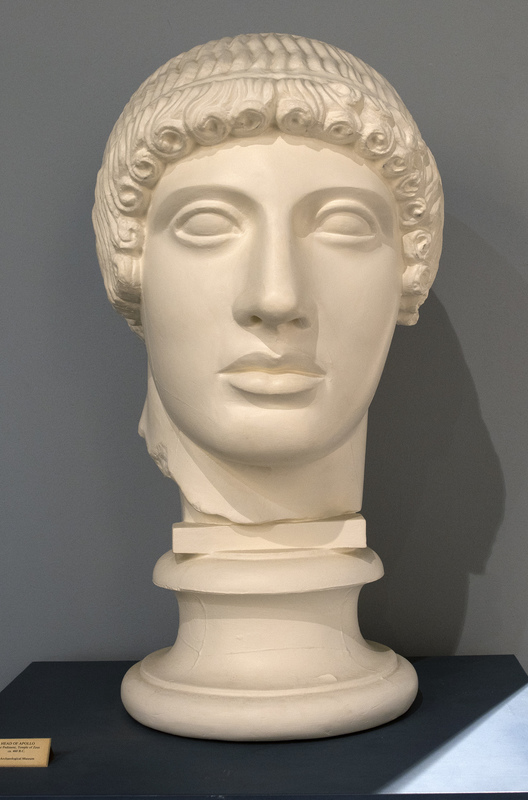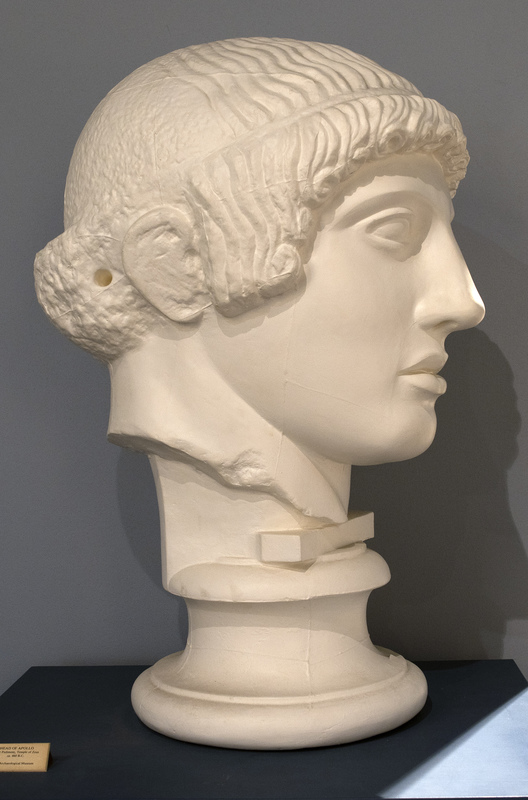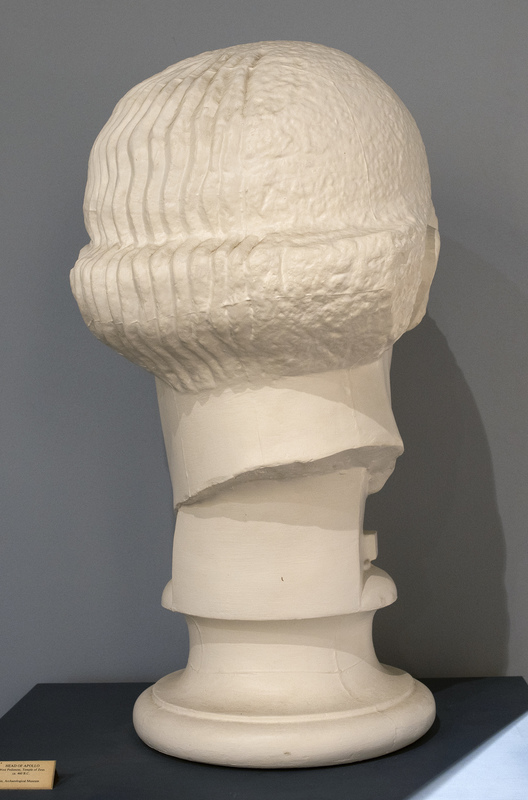-
Title
-
Apollo, Olympia
-
Description
-
Modern plaster replica of the head of Apollo from his statue in the west pediment of the Temple of Zeus at Olympia (built ca. 470-456 BCE), the site of the ancient Olympic games in the northwestern Peloponnese. The original marble Apollo is in the Archaeological Museum of Olympia; it is carved from imported Parian marble and stands 8 ft 4 in high. Surviving tool marks on the body of the god indicate several phases of repair, and probably at least two instances when earthquakes toppled the statue out of the pediment. Figure L. Original H. of figure 3.1 m. (8 ft. 4 in.).
Olympia, the major mainland Greek sanctuary of Zeus (Roman Jupiter), was located near the confluence of two rivers in the northwest corner of the Peloponnese (Olympia is not to be confused with Mt. Olympus in north central Greece, the supposed home of the gods). The temple, built of shelly limestone, was the largest Doric temple in the Peloponnese and had an ambitious program of sculpture: 6 carved metopes over each porch showing the 12 Labors of Herakles, and two pedimental ensembles in the triangular spaces at the front and back of the building. The front (east) pediment shows Zeus himself officiating at the first, mythological, chariot race at the sanctuary. The back (west) pediment depicts a brawl at the wedding feast of the hero Pirithoös and his wife, Deidameia; centaurs (half-man, halfhorse) were also invited to the feast, where they got drunk and began assaulting the Greek guests.
The over life-sized statue of Apollo - symbolizing civilized behavior – stood in the center; his calm epiphany imposes order on the melee. The figure of Apollo is an outstanding example of the Severe style, which flourished between 480 and 450, immediately before the High Classical period represented by the Parthenon. The god stands frontal in the center of the pediment, nude but for a cloak or mantle draped around his back which falls in flat folds over his right shoulder and wraps around his left forearm. He turns his head to the right and extends his right arm horizontally. This arm is not "pieced" from a separate block of marble: the entire figure was carved as a single entity. Consequently, this arm would have to have been supported, and it probably rested on the top of a centaur's head who had come too close to the god's altar. Apollo's left hand reveals a rectangular cutting with a drilled hole on the wrist where a bow was once attached, perhaps of gilded bronze. The youthful head, broken from the body at the neck, is oval with thick lidded eyes, a straight "classical" nose, and mouth with slightly parted lips and an impassive expression. The hair is rendered in thick, slightly wavy strands which emanate from a single point on the top of the head; over the forehead these form a fringe ending in small curls. Behind the ears, Apollo had long, shoulder-length hair which seems short because it has been gathered into a roll at the back of the head. A drilled hole in the center of the roll indicates where a hair pin, probably also of gilded bronze, was attached. Because the right side of the head was turned to the wall of the pediment, and only the left was visible to the spectator at ground level, the sculptor did not carved the back of the head fully. In the Wilcox display, you can see that the right ear has only been roughed out but not finished, and the separation of strands of hair from the rest of the block stops abruptly. An examination of the other pedimental figures reveals that many of them are unfinished as well. Some details could have been added in paint, but most of the unfinished areas would not have been noticeable from ground after the statues were installed in the pediment. Since the carved metopes also include unfinished areas, it is likely that all the sculptures were put into place on the building in a hurry, perhaps so that the temple, begun ca. 470, would be complete for the Olympic games of 456 B.C. The games were celebrated every four years, and drew visitors and contestants from all over the Greek world.
-
Bibliography
-
Ashmole, B., and N. Yalouris. 1967. Olympia. The Sculptures of the Temple of Zeus (New York) 17-18, pls. 101-109.
Boardman, J. 1985. Greek Sculpture. The Classical Period (London) frontispiece (head of Apollo), 33-50, figt. 21.3.
Hornblower, S., and Spawforth, A. (eds.) 1996. The Oxford Classical Dictionary (Oxford) 1065 (Olympia). [abbreviated OCD]
LIMC II.1.183-64 (Apollo). [LIMC = Lexicon Iconographicum Mythologiae Classicae (a comprehensive myth and art encyclopedia: a copy is available in the reference section of Spencer Art & Architecture Library at KU]
Lullies, R., and M. Hirmer. 1960. Greek Sculpture (New York) pls. 120-121.
Rehak, P. 1997. "Unfinished Hair and the Installation of the Pedimental Sculptures in the Temple of Zeus at Olympia," in M. Sturgeon and K. Hartswick (eds). Stephanos. Studies in Honor of Brunilde S. Ridgway ---
Ridgway, B.S. 1970. The Severe Style in Greek Sculpture (Princeton) 17-23, pl. 73.
Robertson, M. 1975. History of Greek Art (---) ---.
Robertson, M. 1981. A Shorter History of Greek Art (Cambridge) 79-89, 86 fig. 126: view of the west pediment.
Rolley, C. 1999. La Sculpture Grecque, 2. Lapériode classique (Paris) ---.
Stewart, A. 1990. Greek Sculpture. An Exploration (New Haven) pl. 270.
-
Iconography
-
Apollo
-
Findspot
-
Olympia



